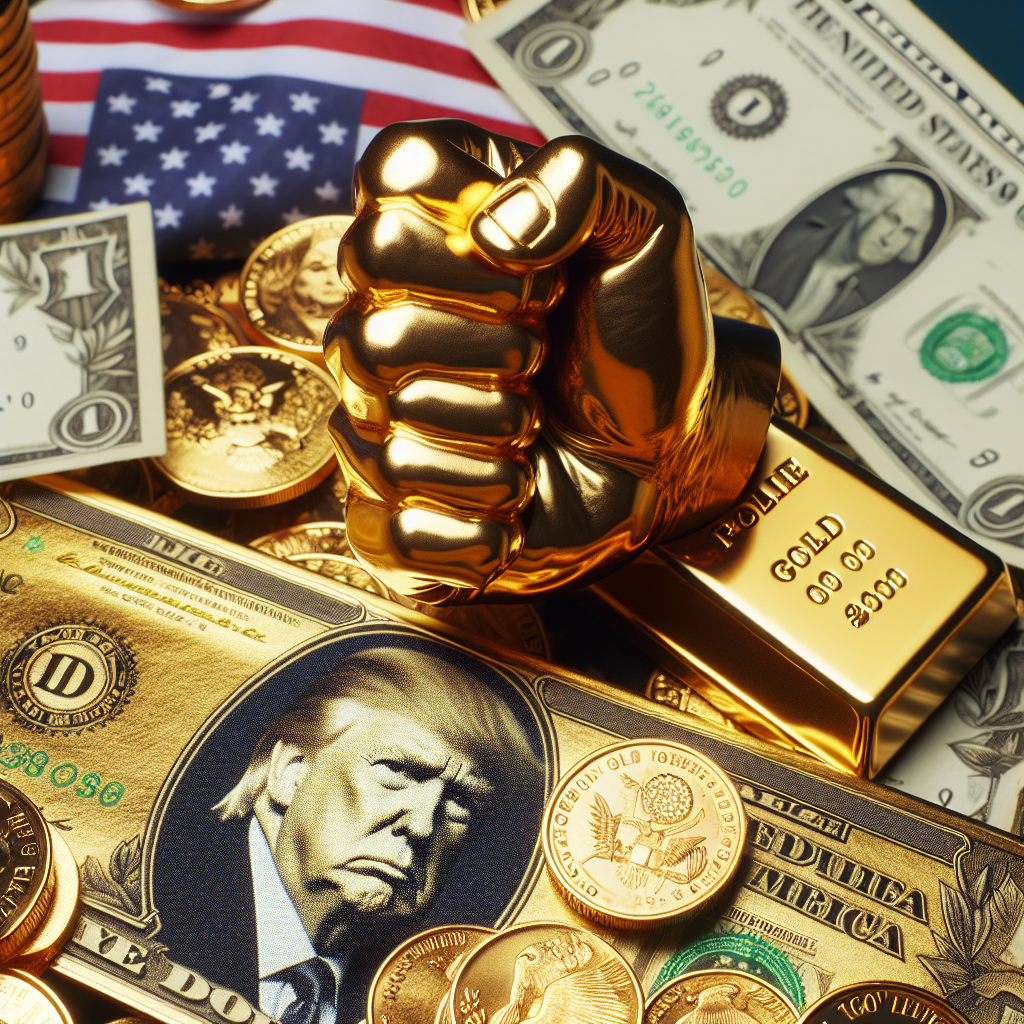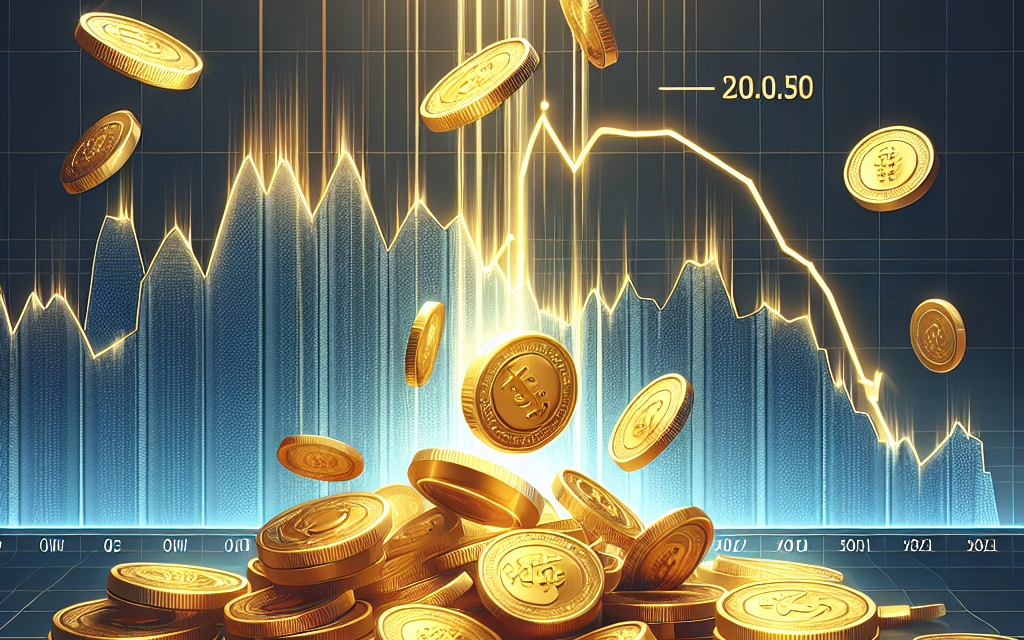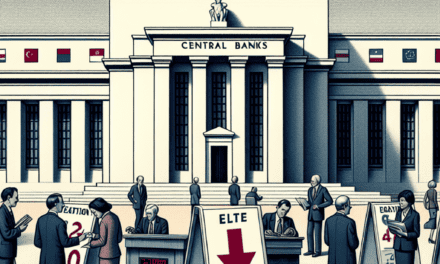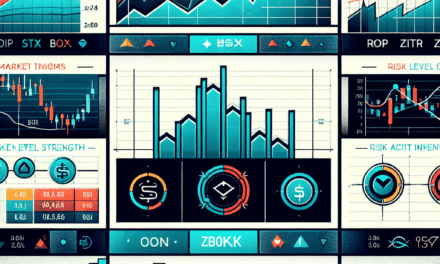“Gold Tumbles: Markets React to Trump’s Victory, Reaching 2021 Lows”
Introduction
Gold prices have experienced a significant decline, reaching their lowest weekly level since 2021, in the wake of Donald Trump’s recent electoral victory. This unexpected political development has triggered a wave of market reactions, with investors reassessing their portfolios amidst shifting economic and geopolitical landscapes. The drop in gold prices reflects a broader trend of market volatility, as traders and analysts attempt to gauge the potential impacts of Trump’s policies on global trade, fiscal stimulus, and monetary policy. As a traditional safe-haven asset, gold’s price movements are often influenced by investor sentiment and economic uncertainty, making this recent plunge a noteworthy event in the financial markets.
Impact Of Trump’s Win On Global Gold Markets
The recent plunge in gold prices to their lowest weekly level since 2021 has sent ripples through the global markets, marking a significant shift in investor sentiment following Donald Trump’s unexpected electoral victory. This development has prompted analysts and market participants to reassess the dynamics influencing the precious metal’s valuation. Historically, gold has been perceived as a safe-haven asset, attracting investors during times of political uncertainty and economic instability. However, the current scenario presents a paradox, as Trump’s win, which many anticipated would bolster gold prices due to potential geopolitical tensions and economic unpredictability, has instead led to a decline.
One of the primary factors contributing to this unexpected downturn is the strengthening of the U.S. dollar. Following Trump’s victory, the dollar surged, driven by expectations of fiscal stimulus, tax reforms, and deregulation, which are anticipated to spur economic growth. A stronger dollar typically exerts downward pressure on gold prices, as it makes the metal more expensive for holders of other currencies, thereby reducing demand. Consequently, investors have shifted their focus towards dollar-denominated assets, perceiving them as more lucrative in the current economic climate.
Moreover, the prospect of rising interest rates has further compounded the decline in gold prices. The Federal Reserve, in response to anticipated fiscal expansion and inflationary pressures under Trump’s administration, is expected to adopt a more hawkish stance. Higher interest rates increase the opportunity cost of holding non-yielding assets like gold, prompting investors to reallocate their portfolios towards interest-bearing securities. This shift in investment strategy has contributed to the waning appeal of gold as a preferred asset class.
In addition to these economic factors, market sentiment has played a crucial role in the recent price movements. Trump’s victory has instilled a sense of optimism among investors, with many viewing his pro-business policies as a catalyst for economic growth. This optimism has translated into increased risk appetite, with investors gravitating towards equities and other riskier assets, further diminishing the allure of gold. The stock market’s robust performance in the wake of the election has underscored this trend, as investors seek to capitalize on potential gains in a Trump-led economy.
However, it is essential to recognize that the current decline in gold prices may not be indicative of a long-term trend. Geopolitical uncertainties, such as trade tensions and diplomatic conflicts, continue to loom on the horizon, posing potential risks that could reignite demand for safe-haven assets. Additionally, the implementation of Trump’s policies remains subject to legislative approval and execution, introducing an element of unpredictability that could influence market dynamics.
In conclusion, the plunge in gold prices following Trump’s electoral victory underscores the complex interplay of economic, political, and psychological factors shaping the global gold markets. While the immediate reaction has been characterized by a shift away from gold, the evolving geopolitical landscape and policy developments will likely continue to influence investor behavior. As such, market participants must remain vigilant, adapting their strategies to navigate the uncertainties that lie ahead. The current scenario serves as a reminder of the inherent volatility in financial markets, where perceptions and expectations can swiftly alter the trajectory of asset prices.
Analyzing The Factors Behind The Recent Gold Price Drop
The recent plunge in gold prices to their lowest weekly level since 2021 has captured the attention of investors and analysts alike, prompting a closer examination of the factors contributing to this significant market movement. Following the unexpected victory of Donald Trump in the recent election, the financial markets have experienced a wave of volatility, with gold prices being particularly affected. Traditionally viewed as a safe-haven asset, gold often experiences price fluctuations in response to geopolitical events and shifts in investor sentiment. In this context, understanding the dynamics behind the recent drop in gold prices requires a multifaceted analysis of both global economic conditions and market psychology.
To begin with, the election of Donald Trump has introduced a degree of uncertainty into the global economic landscape. Historically, political transitions can lead to market instability as investors reassess their portfolios in light of potential policy changes. Trump’s win has been no exception, with his administration’s proposed economic policies, including tax cuts and increased infrastructure spending, sparking debates about their potential impact on inflation and interest rates. As a result, investors have been recalibrating their expectations, leading to fluctuations in asset prices, including gold.
Moreover, the strengthening of the U.S. dollar has played a crucial role in the recent decline in gold prices. As gold is priced in dollars, a stronger dollar makes gold more expensive for foreign investors, thereby reducing demand. The anticipation of higher interest rates under Trump’s administration has contributed to the dollar’s appreciation, as investors expect the Federal Reserve to tighten monetary policy in response to potential inflationary pressures. Consequently, the inverse relationship between the dollar and gold has exerted downward pressure on gold prices.
In addition to these macroeconomic factors, market sentiment has also influenced the recent trajectory of gold prices. Following Trump’s victory, there has been a shift in investor sentiment towards riskier assets, such as equities, as optimism about potential economic growth has overshadowed concerns about geopolitical risks. This shift has led to a reallocation of capital away from safe-haven assets like gold, further contributing to its price decline. The stock market rally observed in the aftermath of the election is indicative of this broader trend, as investors have shown a renewed appetite for risk.
Furthermore, it is essential to consider the role of speculative trading in the gold market. Speculators, who often seek to profit from short-term price movements, can exacerbate price volatility. In the wake of Trump’s win, speculative activity in the gold market has intensified, with traders adjusting their positions in response to changing market conditions. This heightened level of speculative trading has likely amplified the recent downward trend in gold prices.
In conclusion, the recent plunge in gold prices to their lowest weekly level since 2021 can be attributed to a confluence of factors, including the political uncertainty following Trump’s election, the strengthening of the U.S. dollar, shifts in investor sentiment, and increased speculative trading. As the global economic landscape continues to evolve, it remains to be seen how these dynamics will influence the future trajectory of gold prices. Investors and analysts will undoubtedly continue to monitor these developments closely, seeking to navigate the complexities of the market in an era marked by both challenges and opportunities.
Historical Gold Price Trends Post-U.S. Elections
In the wake of Donald Trump’s unexpected victory in the recent U.S. presidential election, gold prices have experienced a significant decline, reaching their lowest weekly level since 2021. This development has captured the attention of investors and analysts alike, prompting a closer examination of historical gold price trends following U.S. elections. Understanding these trends is crucial for comprehending the current market dynamics and anticipating future movements.
Historically, gold has been perceived as a safe-haven asset, often experiencing price fluctuations in response to political and economic uncertainties. U.S. presidential elections, in particular, have been pivotal events that influence investor sentiment and, consequently, gold prices. In the past, elections have often led to increased volatility in the gold market, as investors reassess their portfolios in light of potential policy changes and economic shifts.
For instance, during the 2008 financial crisis, the election of Barack Obama coincided with a surge in gold prices. Investors sought refuge in gold amid fears of economic instability and the potential for inflationary pressures resulting from government stimulus measures. Similarly, in 2016, when Donald Trump first won the presidency, gold prices initially spiked due to concerns over his unorthodox policy proposals and the uncertainty surrounding his administration’s impact on global trade and economic growth.
However, the current scenario presents a different narrative. Following Trump’s recent victory, gold prices have plummeted, defying the traditional safe-haven status of the precious metal. Several factors contribute to this unexpected trend. Firstly, the market’s initial reaction to Trump’s win has been characterized by a surge in risk appetite, with investors favoring equities and other riskier assets over gold. This shift in sentiment can be attributed to expectations of pro-business policies, tax cuts, and deregulation, which are anticipated to stimulate economic growth and boost corporate profits.
Moreover, the strengthening of the U.S. dollar has exerted additional downward pressure on gold prices. As gold is priced in dollars, a stronger dollar makes the metal more expensive for foreign investors, reducing its appeal. The dollar’s appreciation can be linked to the anticipation of higher interest rates under Trump’s administration, as well as the Federal Reserve’s commitment to normalizing monetary policy.
Furthermore, the geopolitical landscape has also played a role in shaping gold price trends. While Trump’s presidency has introduced a degree of uncertainty, particularly in terms of international relations and trade policies, the absence of immediate geopolitical crises has tempered the demand for gold as a safe-haven asset. Investors appear to be adopting a wait-and-see approach, assessing the potential implications of Trump’s policies before making significant adjustments to their portfolios.
In conclusion, the recent plunge in gold prices following Trump’s victory marks a departure from historical trends observed in the aftermath of U.S. elections. While gold has traditionally served as a refuge during times of uncertainty, the current market dynamics reflect a complex interplay of factors, including investor sentiment, currency fluctuations, and geopolitical considerations. As the global economic landscape continues to evolve, it remains to be seen whether gold will regain its luster as a safe-haven asset or if this downward trend will persist. Investors and analysts will undoubtedly keep a close watch on these developments, seeking to navigate the ever-changing terrain of the gold market.
Investor Reactions To Gold’s Decline After Trump’s Victory

In the wake of Donald Trump’s unexpected electoral victory, the financial markets have been thrown into a state of flux, with gold prices experiencing a significant decline. This downturn marks the lowest weekly level for gold since 2021, prompting a wave of reactions from investors who are now reassessing their strategies in light of the new political landscape. The decline in gold prices can be attributed to a confluence of factors, each contributing to the shifting dynamics of the market. As investors digest the implications of Trump’s win, the traditional role of gold as a safe-haven asset is being reevaluated, leading to a complex interplay of market forces.
Initially, the uncertainty surrounding the election results had driven investors towards gold, a typical refuge during times of political and economic instability. However, as the dust settled and Trump’s victory became apparent, market sentiment shifted dramatically. The anticipation of pro-business policies, including tax cuts and deregulation, has fueled optimism about economic growth, thereby reducing the immediate need for safe-haven assets like gold. Consequently, investors have begun reallocating their portfolios, favoring equities and other riskier assets that are expected to benefit from the anticipated economic policies of the Trump administration.
Moreover, the strengthening of the U.S. dollar has played a pivotal role in the decline of gold prices. As the dollar appreciates, gold, which is priced in dollars, becomes more expensive for foreign investors, thereby dampening demand. The prospect of rising interest rates under a Trump presidency has further bolstered the dollar, as higher rates typically attract foreign capital seeking better returns. This dynamic has created a challenging environment for gold, which does not yield interest and thus becomes less attractive in a rising rate scenario.
In addition to these economic factors, investor sentiment has been influenced by the broader geopolitical landscape. Trump’s foreign policy stance, characterized by a focus on national interests and potential trade renegotiations, has introduced a new layer of complexity to global markets. While some investors view these policies as a potential source of volatility that could eventually support gold prices, others perceive them as opportunities for economic realignment that could spur growth and reduce the need for traditional hedges.
As investors navigate this evolving environment, their reactions have been varied. Some have chosen to maintain their positions in gold, viewing the current dip as a temporary fluctuation in a long-term upward trend driven by global uncertainties. Others have opted to diversify their holdings, seeking exposure to sectors poised to benefit from the anticipated policy shifts. This divergence in strategies underscores the complexity of the current market landscape, where traditional investment paradigms are being challenged by new political realities.
In conclusion, the plunge in gold prices following Trump’s victory reflects a multifaceted response from investors grappling with the implications of a changing economic and political environment. As the market continues to adjust, the interplay between policy expectations, currency movements, and geopolitical factors will remain crucial in shaping investor behavior. While the immediate outlook for gold appears uncertain, the evolving landscape presents both challenges and opportunities for those willing to adapt their strategies in response to the shifting tides.
Comparing Gold’s Performance With Other Precious Metals
In the wake of Donald Trump’s recent electoral victory, gold prices have experienced a significant decline, reaching their lowest weekly level since 2021. This unexpected downturn has prompted investors and analysts to closely examine the performance of gold in comparison to other precious metals. As the market reacts to the political shift, it is crucial to understand the dynamics influencing gold’s value and how it stands relative to its counterparts such as silver, platinum, and palladium.
To begin with, gold has traditionally been viewed as a safe-haven asset, particularly during times of political and economic uncertainty. However, the recent election outcome has led to a shift in market sentiment, with investors seemingly more optimistic about economic growth prospects under Trump’s leadership. This optimism has resulted in a stronger U.S. dollar and rising interest rates, both of which exert downward pressure on gold prices. As gold is priced in dollars, a stronger dollar makes it more expensive for foreign investors, thereby reducing demand.
In contrast, silver, often considered gold’s less glamorous sibling, has shown a relatively stable performance. While it too has been affected by the strengthening dollar, silver’s industrial applications provide a buffer against the volatility seen in gold. The metal’s use in electronics, solar panels, and other industrial sectors ensures a steady demand, which helps mitigate the impact of currency fluctuations. Consequently, silver’s price decline has been less pronounced than that of gold, highlighting its dual role as both a precious and industrial metal.
Meanwhile, platinum and palladium have exhibited distinct trends, driven largely by their industrial uses. Platinum, primarily used in the automotive industry for catalytic converters, has faced challenges due to a slowdown in car production and a shift towards electric vehicles, which do not require catalytic converters. This has led to a subdued performance compared to gold. However, palladium, which is also used in catalytic converters, has benefited from stricter emissions regulations worldwide, particularly in China and Europe. These regulations have increased demand for palladium, resulting in a more resilient price performance relative to gold.
Furthermore, the geopolitical landscape plays a crucial role in shaping the performance of these metals. While gold is heavily influenced by macroeconomic factors such as interest rates and currency strength, platinum and palladium are more sensitive to changes in industrial demand and supply chain disruptions. For instance, geopolitical tensions in major platinum-producing regions like South Africa can lead to supply constraints, impacting prices. Similarly, trade policies and tariffs can affect the availability and cost of palladium, influencing its market dynamics.
In conclusion, the recent plunge in gold prices following Trump’s win underscores the complex interplay of factors that influence the precious metals market. While gold remains a key asset for investors seeking stability, its performance is increasingly being challenged by economic and political developments. In comparison, silver’s industrial applications provide a degree of resilience, while platinum and palladium’s fortunes are closely tied to the automotive industry and regulatory changes. As the global economic landscape continues to evolve, investors must remain vigilant, considering both macroeconomic indicators and sector-specific trends to navigate the intricate world of precious metals.
Economic Implications Of Falling Gold Prices In 2021
The recent plunge in gold prices to their lowest weekly level since 2021, following Donald Trump’s unexpected electoral victory, has sparked widespread discussion about the economic implications of this development. Gold, traditionally seen as a safe-haven asset, often experiences fluctuations in response to geopolitical events and shifts in investor sentiment. The decline in gold prices can be attributed to a complex interplay of factors, each contributing to the broader economic landscape.
To begin with, the immediate aftermath of Trump’s win saw a surge in investor confidence in the U.S. economy. This optimism was largely driven by expectations of pro-business policies, including tax cuts and deregulation, which were anticipated to stimulate economic growth. As a result, investors shifted their focus towards riskier assets such as stocks, leading to a sell-off in gold. This shift in investment strategy underscores the inverse relationship between gold prices and stock market performance, where a robust stock market often results in diminished demand for gold.
Moreover, the strengthening of the U.S. dollar played a significant role in the decline of gold prices. As the dollar appreciates, gold becomes more expensive for holders of other currencies, thereby reducing its attractiveness as an investment. The anticipation of interest rate hikes by the Federal Reserve further bolstered the dollar, as higher interest rates tend to attract foreign capital, enhancing the currency’s value. Consequently, the combination of a strong dollar and rising interest rates exerted downward pressure on gold prices.
In addition to these factors, the global economic environment also contributed to the fall in gold prices. The gradual recovery of major economies from the pandemic-induced recession led to increased industrial activity and consumer spending, reducing the need for safe-haven assets. Furthermore, the rollout of COVID-19 vaccines and subsequent easing of restrictions instilled a sense of optimism about future economic prospects, prompting investors to reallocate their portfolios towards growth-oriented assets.
However, it is essential to consider the broader economic implications of falling gold prices. For countries that are major gold producers, such as South Africa and Australia, a sustained decline in gold prices could adversely impact their economies. Lower gold prices can lead to reduced revenues from gold exports, affecting national income and potentially leading to job losses in the mining sector. This scenario underscores the interconnectedness of global markets and the ripple effects that fluctuations in commodity prices can have on national economies.
On the other hand, for countries that are net importers of gold, lower prices could be beneficial. Reduced costs for gold imports can help improve trade balances and provide a boost to industries reliant on gold, such as jewelry manufacturing. Additionally, consumers may benefit from lower prices for gold products, potentially increasing demand in the retail sector.
In conclusion, the plunge in gold prices following Trump’s electoral victory highlights the intricate dynamics of global financial markets. While the immediate reaction was driven by investor sentiment and macroeconomic factors, the long-term implications will depend on how these elements evolve. As the world continues to navigate the complexities of economic recovery and geopolitical shifts, the trajectory of gold prices will remain a focal point for investors and policymakers alike. Understanding these dynamics is crucial for anticipating future trends and making informed decisions in an ever-changing economic landscape.
Future Predictions For Gold Prices In A Trump-Led Economy
In the wake of Donald Trump’s recent electoral victory, gold prices have experienced a significant downturn, reaching their lowest weekly level since 2021. This unexpected shift in the precious metals market has prompted investors and analysts alike to reassess their strategies and predictions for the future of gold prices in a Trump-led economy. As we delve into the potential implications of this political change, it is crucial to consider the various factors that could influence gold’s trajectory in the coming years.
To begin with, it is essential to understand the historical context of gold prices in relation to political events. Traditionally, gold has been perceived as a safe-haven asset, attracting investors during times of economic uncertainty or geopolitical tension. However, Trump’s victory has introduced a new set of variables that could alter this dynamic. His administration’s economic policies, particularly those related to fiscal stimulus, tax reforms, and deregulation, are expected to have a profound impact on the U.S. economy. These policies could potentially lead to increased economic growth and higher interest rates, which might diminish gold’s appeal as an investment.
Moreover, the strength of the U.S. dollar plays a pivotal role in determining gold prices. Historically, there has been an inverse relationship between the value of the dollar and gold prices. As Trump’s policies are anticipated to bolster the dollar, this could exert downward pressure on gold. Additionally, the Federal Reserve’s monetary policy decisions will be crucial in shaping the future of gold prices. Should the Fed decide to raise interest rates in response to a stronger economy, this could further dampen gold’s attractiveness, as higher interest rates typically lead to increased yields on bonds and other fixed-income investments, making them more appealing compared to non-yielding assets like gold.
Furthermore, it is important to consider the global economic landscape and its potential impact on gold prices. While Trump’s domestic policies may strengthen the U.S. economy, international factors such as trade tensions, geopolitical conflicts, and economic instability in other regions could still drive demand for gold as a safe-haven asset. For instance, ongoing trade disputes or political unrest in key regions could create an environment of uncertainty, prompting investors to seek refuge in gold despite a strong dollar and rising interest rates.
In addition to these economic and geopolitical considerations, market sentiment and investor behavior will also play a significant role in shaping the future of gold prices. The psychological aspect of investing cannot be underestimated, as perceptions of risk and opportunity often drive market movements. As such, any shifts in investor confidence or changes in market sentiment could lead to fluctuations in gold prices, regardless of underlying economic fundamentals.
In conclusion, while gold prices have recently plunged to their lowest weekly level since 2021 following Trump’s win, the future trajectory of gold in a Trump-led economy remains uncertain. A complex interplay of factors, including domestic economic policies, global economic conditions, and investor sentiment, will ultimately determine the direction of gold prices in the coming years. As investors navigate this evolving landscape, it will be crucial to remain vigilant and adaptable, continuously reassessing strategies in response to new developments and emerging trends.
Q&A
1. **What event is associated with the plunge in gold prices?**
The plunge in gold prices is associated with Donald Trump’s win.
2. **To what level did gold prices fall?**
Gold prices fell to their lowest weekly level since 2021.
3. **What is the general market reaction to Trump’s win in relation to gold?**
The market reacted to Trump’s win by causing a decrease in gold prices.
4. **What is a possible reason for the decline in gold prices following Trump’s win?**
A possible reason could be increased investor confidence in the economy, leading to a shift from safe-haven assets like gold to riskier investments.
5. **How do gold prices typically react to political events?**
Gold prices often react to political events by either increasing due to uncertainty or decreasing if the event boosts economic confidence.
6. **What is the significance of gold reaching its lowest level since 2021?**
It indicates a significant drop in demand or confidence in gold as a safe-haven asset compared to previous years.
7. **What might investors do in response to falling gold prices?**
Investors might diversify their portfolios, moving funds into equities or other assets perceived as having better growth potential.
Conclusion
The plunge in gold prices to their lowest weekly level since 2021, following Trump’s win, can be attributed to a shift in investor sentiment and market dynamics. Typically, gold is seen as a safe-haven asset during times of uncertainty. However, Trump’s victory may have led to increased confidence in economic growth and stability, prompting investors to move away from gold and into riskier assets like stocks. Additionally, expectations of potential policy changes, such as tax cuts and deregulation, could have bolstered optimism about economic expansion, further reducing the appeal of gold. This shift in market sentiment underscores the complex interplay between political events and financial markets, highlighting how investor perceptions and expectations can significantly impact commodity prices.





